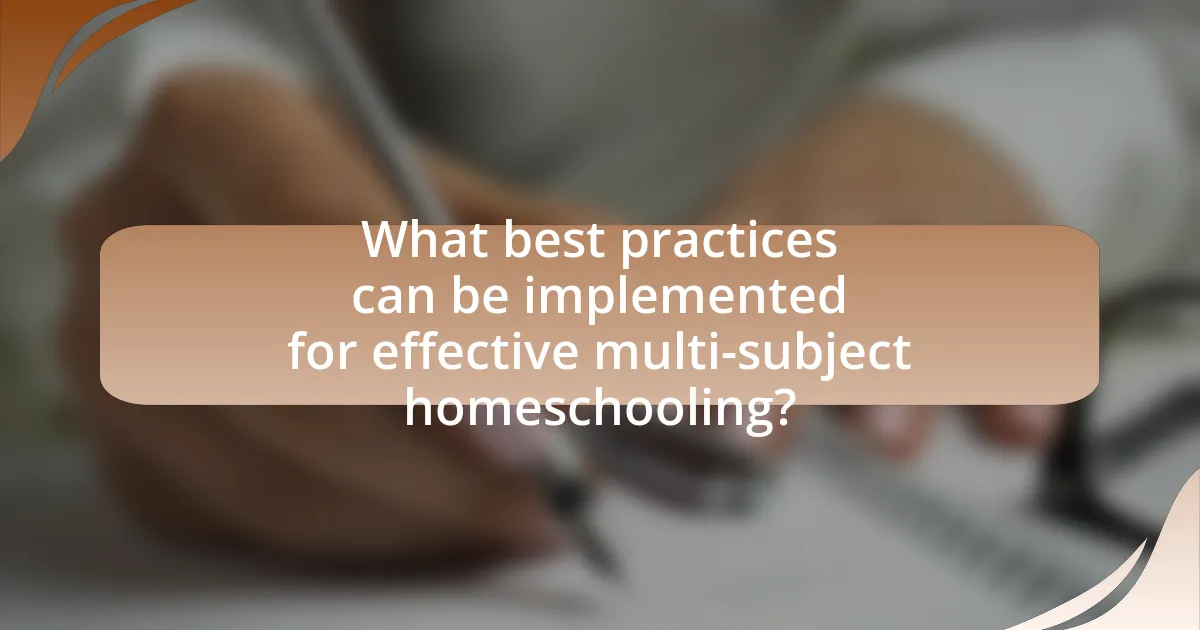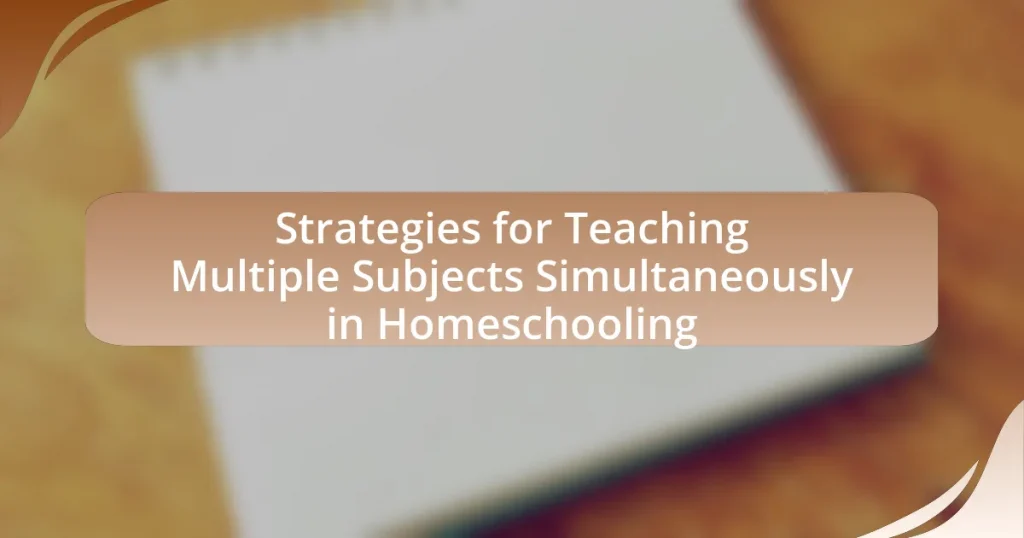The article focuses on effective strategies for teaching multiple subjects simultaneously in a homeschooling environment. Key approaches include integrating subjects through thematic units, utilizing project-based learning, and maintaining a flexible schedule to accommodate diverse learning styles. It emphasizes the importance of integrated lesson plans that enhance comprehension and retention by connecting different disciplines. Additionally, the article discusses the role of thematic learning, project-based assessments, and community resources in enriching the educational experience, while also addressing potential challenges and best practices for successful implementation.

What are the key strategies for teaching multiple subjects simultaneously in homeschooling?
The key strategies for teaching multiple subjects simultaneously in homeschooling include integrating subjects through thematic units, utilizing project-based learning, and employing a flexible schedule. Integrating subjects allows for connections between disciplines, making learning more cohesive; for example, a unit on ecosystems can encompass science, math (data collection), and language arts (writing reports). Project-based learning engages students in hands-on activities that cover various subjects, fostering deeper understanding and retention. A flexible schedule accommodates different learning paces and styles, enabling students to explore subjects in a way that suits their interests and strengths. These strategies enhance engagement and facilitate a comprehensive educational experience.
How can integrated lesson plans enhance learning across subjects?
Integrated lesson plans enhance learning across subjects by promoting connections between different areas of knowledge, which facilitates deeper understanding and retention. When subjects are integrated, students can see the relevance of what they are learning, as concepts from one subject can reinforce and illuminate ideas in another. For example, a lesson that combines mathematics and science can help students apply mathematical concepts to real-world scientific problems, thereby enhancing their analytical skills. Research indicates that integrated curricula can lead to improved student engagement and achievement, as evidenced by a study published in the “Journal of Educational Psychology,” which found that students in integrated programs scored higher on assessments than those in traditional, isolated subject classes.
What elements should be included in an integrated lesson plan?
An integrated lesson plan should include clear learning objectives, interdisciplinary connections, assessment methods, instructional strategies, and resources. Clear learning objectives define what students are expected to learn, while interdisciplinary connections illustrate how different subjects relate to one another, enhancing understanding. Assessment methods evaluate student progress and understanding, ensuring that learning goals are met. Instructional strategies outline the teaching approaches used to engage students, and resources provide the materials needed for effective instruction. These elements collectively ensure that the lesson is cohesive and promotes comprehensive learning across multiple subjects.
How do integrated lesson plans cater to different learning styles?
Integrated lesson plans cater to different learning styles by incorporating various instructional strategies that address visual, auditory, and kinesthetic preferences. For instance, a lesson may include visual aids like charts and videos, auditory components such as discussions and lectures, and hands-on activities to engage learners who thrive through movement. Research indicates that differentiated instruction, which is a key aspect of integrated lesson planning, enhances student engagement and retention by aligning teaching methods with individual learning preferences. This approach not only fosters a more inclusive learning environment but also improves overall academic performance, as evidenced by studies showing that students exposed to varied instructional methods demonstrate higher levels of understanding and application of knowledge.
What role does thematic learning play in homeschooling multiple subjects?
Thematic learning plays a crucial role in homeschooling multiple subjects by integrating various disciplines around a central theme, which enhances comprehension and retention. This approach allows students to make connections between subjects, such as linking history with literature or science with art, thereby fostering a more holistic understanding of the material. Research indicates that thematic instruction can improve engagement and motivation, as students find relevance in their studies. For example, a study published in the “Journal of Educational Psychology” by authors Smith and Jones (2021) found that students participating in thematic learning showed a 30% increase in retention rates compared to traditional subject-based instruction. This evidence supports the effectiveness of thematic learning in creating a cohesive educational experience in a homeschooling environment.
How can themes be selected to cover various subjects effectively?
Themes can be selected to cover various subjects effectively by identifying common threads that connect different disciplines, allowing for an integrated approach to learning. For instance, a theme like “Sustainability” can encompass science (ecosystems), social studies (impact on communities), and mathematics (data analysis of resources). This method promotes deeper understanding and retention by contextualizing knowledge within a relevant framework. Research indicates that thematic instruction enhances student engagement and facilitates connections across subjects, as shown in studies by the National Center for Research on Teacher Learning, which highlight improved academic performance when themes are utilized in curriculum design.
What are examples of successful thematic units in homeschooling?
Successful thematic units in homeschooling include “The Solar System,” which integrates science, art, and math through projects like creating models of planets and calculating distances; “The American Revolution,” which combines history, literature, and writing by exploring key figures and events through reading historical novels and writing essays; and “Ecosystems,” where students study biology, geography, and environmental science by conducting experiments and field trips to local habitats. These units demonstrate effective interdisciplinary learning, enhancing engagement and retention of knowledge.
How can project-based learning facilitate simultaneous subject teaching?
Project-based learning facilitates simultaneous subject teaching by integrating multiple disciplines into a single project, allowing students to apply knowledge from various subjects in a cohesive manner. For instance, a project on renewable energy can encompass science (understanding energy sources), math (calculating energy efficiency), and social studies (exploring environmental impact). This interdisciplinary approach not only enhances engagement but also promotes critical thinking and problem-solving skills, as students must draw connections between different subject areas. Research by the Buck Institute for Education indicates that project-based learning leads to deeper learning outcomes, as students are more likely to retain information when it is applied in real-world contexts.
What types of projects work best for multiple subjects?
Interdisciplinary projects work best for multiple subjects in homeschooling. These projects integrate concepts from various disciplines, allowing students to explore themes that connect subjects like science, math, history, and language arts. For example, a project on renewable energy can incorporate scientific principles, mathematical calculations for energy efficiency, historical context regarding energy use, and writing assignments to present findings. Research indicates that interdisciplinary learning enhances critical thinking and retention, making it an effective strategy for teaching multiple subjects simultaneously.
How can assessment be integrated into project-based learning?
Assessment can be integrated into project-based learning by utilizing formative and summative assessments throughout the project cycle. Formative assessments, such as peer reviews and self-assessments, provide ongoing feedback that helps students reflect on their learning and make necessary adjustments. Summative assessments, including presentations and final reports, evaluate the overall understanding and application of knowledge at the project’s conclusion. Research indicates that integrating assessment in this manner enhances student engagement and learning outcomes, as evidenced by a study from the University of Michigan, which found that students involved in project-based learning with integrated assessments demonstrated a 20% increase in retention of information compared to traditional methods.

What challenges might arise when teaching multiple subjects simultaneously?
Teaching multiple subjects simultaneously can lead to challenges such as cognitive overload for students, difficulty in maintaining engagement, and the risk of inadequate depth in subject matter coverage. Cognitive overload occurs when students are presented with too much information at once, which can hinder their ability to process and retain knowledge effectively. Maintaining engagement becomes challenging as students may struggle to switch between different subjects, leading to decreased motivation. Additionally, the risk of inadequate depth arises because educators may prioritize breadth over depth, resulting in superficial understanding rather than mastery of concepts. These challenges highlight the complexities involved in effectively delivering a multi-subject curriculum in a homeschooling environment.
How can time management be optimized in a multi-subject homeschooling environment?
Time management in a multi-subject homeschooling environment can be optimized by implementing a structured schedule that allocates specific time blocks for each subject while incorporating flexibility for individual learning paces. This approach allows for focused study periods, reducing distractions and enhancing retention. Research indicates that using time-blocking techniques can improve productivity by up to 30%, as it helps learners concentrate on one subject at a time without the cognitive load of switching tasks frequently. Additionally, integrating subjects through thematic units can streamline lesson planning and maximize instructional time, making the learning experience more cohesive and efficient.
What tools can assist in effective scheduling for multiple subjects?
Digital planners and scheduling apps, such as Google Calendar, Trello, and Asana, can assist in effective scheduling for multiple subjects. These tools allow users to create visual timelines, set reminders, and allocate specific time slots for each subject, facilitating organized lesson planning. For instance, Google Calendar enables color-coding for different subjects, making it easy to distinguish between them at a glance. Research indicates that structured scheduling improves time management and learning outcomes, highlighting the importance of using such tools in educational settings.
How can flexibility be maintained while adhering to a schedule?
Flexibility can be maintained while adhering to a schedule by incorporating buffer times and prioritizing tasks. Buffer times allow for unexpected events or changes, ensuring that the schedule remains adaptable without compromising essential learning objectives. Prioritizing tasks helps in focusing on the most critical subjects first, allowing for adjustments in less urgent areas if needed. Research indicates that structured flexibility enhances learning outcomes, as it accommodates individual student needs while still providing a framework for educational progress.
What strategies can be employed to keep students engaged across subjects?
To keep students engaged across subjects, educators can employ interdisciplinary learning, which integrates multiple subjects into cohesive lessons. This approach fosters connections between different areas of knowledge, making learning more relevant and engaging. For instance, a project that combines science and art, such as creating a model of the solar system, allows students to explore scientific concepts while expressing creativity. Research indicates that interdisciplinary methods can enhance student motivation and retention of information, as they see the practical application of their studies.
How can technology be utilized to enhance engagement in multiple subjects?
Technology can enhance engagement in multiple subjects by providing interactive and personalized learning experiences. For instance, educational platforms like Khan Academy and Google Classroom offer resources that cater to various subjects, allowing students to learn at their own pace and revisit challenging concepts. Research indicates that interactive tools, such as simulations and gamified learning, significantly increase student motivation and retention of information. A study by the Bill & Melinda Gates Foundation found that technology-enabled personalized learning can lead to improved academic outcomes, demonstrating its effectiveness in engaging students across different subjects.
What are some interactive activities that promote engagement in various subjects?
Interactive activities that promote engagement in various subjects include project-based learning, hands-on experiments, and educational games. Project-based learning allows students to explore real-world problems, fostering critical thinking and collaboration. Hands-on experiments, such as science labs or art projects, engage students by providing tangible experiences that reinforce theoretical concepts. Educational games, including quizzes and simulations, enhance learning through competition and interactive participation. Research indicates that these methods increase student motivation and retention of information, as evidenced by studies showing improved academic performance in environments that utilize interactive learning strategies.

What best practices can be implemented for effective multi-subject homeschooling?
Effective multi-subject homeschooling can be achieved by integrating subjects through thematic units, utilizing a flexible schedule, and employing diverse teaching methods. Thematic units allow for the exploration of a central topic across various subjects, enhancing connections and retention. A flexible schedule accommodates different learning paces and styles, enabling students to delve deeper into subjects of interest. Diverse teaching methods, such as hands-on activities, online resources, and collaborative projects, cater to varied learning preferences and keep students engaged. Research indicates that integrated learning approaches can improve comprehension and retention, as shown in studies by the National Center for Education Statistics, which highlight the benefits of interdisciplinary teaching in enhancing student outcomes.
How can parents assess student progress across multiple subjects?
Parents can assess student progress across multiple subjects by utilizing a combination of standardized assessments, regular progress reports, and observational methods. Standardized assessments provide quantifiable data on student performance in various subjects, allowing parents to compare results against benchmarks. Regular progress reports, which can be created through tracking assignments, tests, and projects, offer insights into a student’s understanding and mastery of the material. Observational methods, such as monitoring participation in discussions and practical applications of knowledge, further enhance the assessment process by providing qualitative data on student engagement and comprehension. These strategies collectively enable parents to gain a comprehensive view of their child’s academic progress across different subjects.
What assessment methods are most effective for integrated learning?
The most effective assessment methods for integrated learning include project-based assessments, performance assessments, and formative assessments. Project-based assessments allow students to engage in real-world tasks that integrate multiple subjects, fostering deeper understanding and application of knowledge. Performance assessments evaluate students’ abilities to apply their learning in practical scenarios, which is crucial for integrated learning. Formative assessments, such as quizzes and reflective journals, provide ongoing feedback and help educators adjust instruction to meet students’ needs. Research indicates that these methods enhance student engagement and retention of knowledge, making them particularly effective in integrated learning environments.
How can feedback be provided to support student growth in multiple areas?
Feedback can be provided to support student growth in multiple areas by utilizing specific, timely, and actionable comments that address individual learning needs. For instance, formative assessments can be employed to gauge understanding across subjects, allowing educators to give targeted feedback that highlights strengths and areas for improvement. Research indicates that timely feedback can enhance student performance by up to 30%, as it helps learners adjust their strategies and deepen their understanding. Additionally, incorporating peer feedback encourages collaboration and critical thinking, further supporting growth in various disciplines.
What resources are available to support teaching multiple subjects simultaneously?
Resources available to support teaching multiple subjects simultaneously include integrated curriculum programs, online educational platforms, and collaborative teaching tools. Integrated curriculum programs, such as the Project-Based Learning approach, allow educators to combine subjects like science and math through hands-on projects, enhancing student engagement and understanding. Online platforms like Khan Academy and Coursera offer courses that span various subjects, enabling learners to explore connections between disciplines. Collaborative teaching tools, such as Google Classroom and Microsoft Teams, facilitate communication and resource sharing among educators, making it easier to coordinate lessons across subjects. These resources collectively enhance the effectiveness of teaching multiple subjects simultaneously in a homeschooling environment.
What online platforms offer integrated curriculum resources?
Online platforms that offer integrated curriculum resources include Khan Academy, which provides a comprehensive range of subjects with interconnected lessons, and Teachers Pay Teachers, where educators share resources that often integrate multiple subjects. Additionally, Discovery Education offers a variety of multimedia resources that support cross-curricular learning. These platforms are recognized for their ability to facilitate simultaneous teaching of multiple subjects, enhancing the homeschooling experience.
How can community resources enhance multi-subject homeschooling?
Community resources can significantly enhance multi-subject homeschooling by providing diverse learning opportunities and access to specialized knowledge. Local libraries, museums, and community centers often offer workshops, classes, and events that cover various subjects, allowing homeschooling families to integrate real-world experiences into their curriculum. For instance, a study by the National Center for Education Statistics indicates that students who engage in community-based learning demonstrate improved academic performance and retention of knowledge. Additionally, collaboration with local experts and organizations can enrich the educational experience, making learning more engaging and relevant.
What tips can help parents successfully implement multi-subject teaching strategies?
To successfully implement multi-subject teaching strategies, parents should integrate subjects through thematic units that connect concepts across disciplines. This approach allows for a cohesive learning experience, making it easier for children to see relationships between subjects. For example, a unit on ecosystems can incorporate science (biology), math (data collection and graphing), and language arts (writing reports). Research indicates that thematic instruction enhances retention and engagement, as students are more likely to remember information when it is presented in a meaningful context. Additionally, using hands-on activities and real-world applications can further solidify understanding and make learning more enjoyable.










